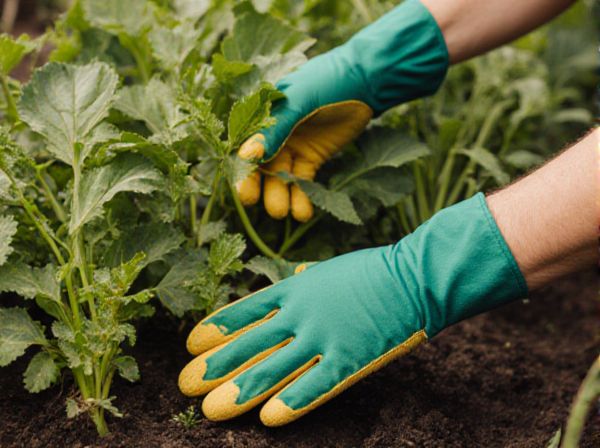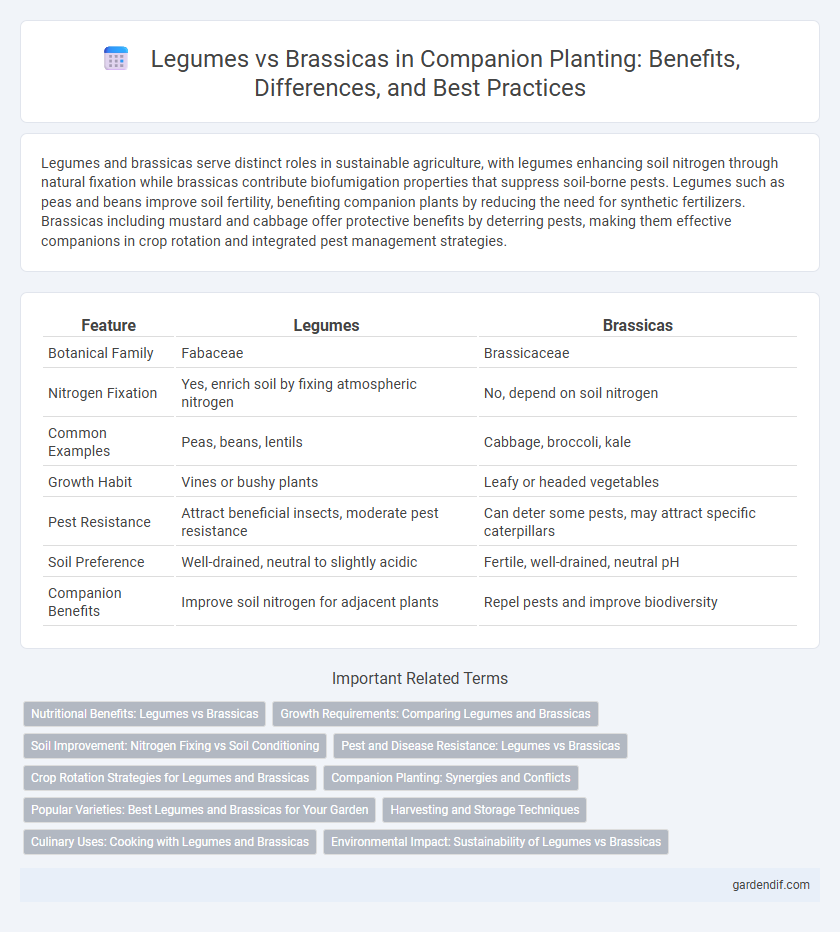
Legumes vs brassicas Illustration
Legumes and brassicas serve distinct roles in sustainable agriculture, with legumes enhancing soil nitrogen through natural fixation while brassicas contribute biofumigation properties that suppress soil-borne pests. Legumes such as peas and beans improve soil fertility, benefiting companion plants by reducing the need for synthetic fertilizers. Brassicas including mustard and cabbage offer protective benefits by deterring pests, making them effective companions in crop rotation and integrated pest management strategies.
Table of Comparison
| Feature | Legumes | Brassicas |
|---|---|---|
| Botanical Family | Fabaceae | Brassicaceae |
| Nitrogen Fixation | Yes, enrich soil by fixing atmospheric nitrogen | No, depend on soil nitrogen |
| Common Examples | Peas, beans, lentils | Cabbage, broccoli, kale |
| Growth Habit | Vines or bushy plants | Leafy or headed vegetables |
| Pest Resistance | Attract beneficial insects, moderate pest resistance | Can deter some pests, may attract specific caterpillars |
| Soil Preference | Well-drained, neutral to slightly acidic | Fertile, well-drained, neutral pH |
| Companion Benefits | Improve soil nitrogen for adjacent plants | Repel pests and improve biodiversity |
Nutritional Benefits: Legumes vs Brassicas
Legumes provide a rich source of plant-based protein, dietary fiber, and essential minerals such as iron, magnesium, and potassium, promoting digestive health and sustained energy release. Brassicas, including broccoli, kale, and cabbage, are high in vitamins C and K, antioxidants, and glucosinolates, compounds linked to reduced cancer risk and enhanced immune function. Combining legumes and brassicas in companion planting not only improves soil nitrogen levels but also offers a diverse nutritional profile that supports overall health and well-being.
Growth Requirements: Comparing Legumes and Brassicas
Legumes thrive in nitrogen-poor soils due to their symbiotic nitrogen-fixing bacteria, requiring moderate water and well-drained, slightly acidic to neutral pH levels for optimal growth. Brassicas prefer alkaline to neutral soils with good fertility and consistent moisture, needing cooler temperatures for optimal development and tolerating heavier, well-drained soils. Understanding these specific growth requirements supports effective companion planting, enhancing soil health and crop yields.
Soil Improvement: Nitrogen Fixing vs Soil Conditioning
Legumes such as beans and peas enhance soil fertility by fixing atmospheric nitrogen through symbiotic bacteria in root nodules, reducing the need for synthetic fertilizers. Brassicas, including mustard and kale, improve soil structure and suppress soil-borne pests through biofumigation, contributing to overall soil conditioning. Integrating legumes and brassicas in crop rotations balances nitrogen enrichment with soil health, optimizing sustainable agricultural practices.
Pest and Disease Resistance: Legumes vs Brassicas
Legumes such as peas and beans exhibit strong resistance to soil-borne diseases like root rot due to their nitrogen-fixing capabilities, which enhance soil health and disrupt pest cycles. Brassicas, including cabbage and broccoli, are prone to specific pests like cabbage worms and clubroot but contain natural glucosinolates that suppress soil pathogens and nematodes. Integrating legumes and brassicas in crop rotations improves overall pest and disease resistance by leveraging legumes' soil enrichment and brassicas' biofumigation properties.
Crop Rotation Strategies for Legumes and Brassicas
Effective crop rotation strategies for legumes and brassicas enhance soil fertility and reduce pest cycles by alternating nitrogen-fixing legumes with nutrient-demanding brassicas. Legumes such as peas and beans improve soil nitrogen levels, benefiting subsequent brassica crops like cabbage and broccoli, which require high nitrogen for optimal growth. Rotating these crops minimizes disease buildup, disrupts pest life cycles, and promotes sustainable yield in companion planting systems.
Companion Planting: Synergies and Conflicts
Legumes enhance soil nitrogen through symbiotic nitrogen fixation, benefiting companion brassicas by improving growth and yield in companion planting systems. Brassicas, however, release allelopathic compounds that can inhibit legume seed germination and root development, requiring strategic spacing to minimize conflicts. Integrating legumes and brassicas optimizes nutrient cycling but demands careful management of planting timing and proximity to harness synergies and avoid antagonistic interactions.
Popular Varieties: Best Legumes and Brassicas for Your Garden
Chickpeas, lentils, and peas are popular legume varieties known for their nitrogen-fixing abilities, enriching garden soil naturally. Among brassicas, kale, broccoli, and Brussels sprouts stand out for their resilience and nutritional value. Combining these legumes and brassicas in crop rotation enhances soil fertility and promotes healthy plant growth.
Harvesting and Storage Techniques
Legumes like peas and beans require harvesting at optimal pod maturity to prevent shattering, with drying typically done in well-ventilated areas to reduce moisture content and preserve seed viability. Brassicas, including cabbage and broccoli, are harvested when heads are firm and mature, and should be stored in cool, humid environments to maintain freshness and extend shelf life. Employing proper timing and controlled atmosphere storage techniques enhances the longevity and quality of both legume and brassica crops in companion planting systems.
Culinary Uses: Cooking with Legumes and Brassicas
Legumes such as lentils, chickpeas, and beans offer a rich source of protein and fiber, making them ideal for hearty soups, stews, and salads. Brassicas including broccoli, cauliflower, and Brussels sprouts provide versatile options for roasting, steaming, and stir-frying, imparting a slightly bitter and nutty flavor. Combining legumes and brassicas in dishes enhances nutritional value and flavor complexity while supporting balanced culinary applications.
Environmental Impact: Sustainability of Legumes vs Brassicas
Legumes improve soil nitrogen levels through biological nitrogen fixation, reducing the need for synthetic fertilizers and lowering greenhouse gas emissions. Brassicas, while effective for biofumigation and soil health, generally require higher input costs and can be more energy-intensive to manage. Choosing legumes over brassicas enhances sustainability by promoting nitrogen cycling and minimizing environmental footprints in crop systems.
Legumes vs brassicas Infographic

 gardendif.com
gardendif.com